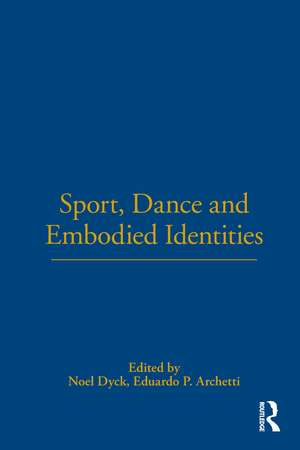Sport, Dance and Embodied Identities
Editat de Noel Dyck, Eduardo P. Archettien Limba Engleză Hardback – iul 2003
Preț: 767.71 lei
Preț vechi: 1104.85 lei
-31% Nou
Puncte Express: 1152
Preț estimativ în valută:
146.90€ • 160.07$ • 123.79£
146.90€ • 160.07$ • 123.79£
Carte tipărită la comandă
Livrare economică 24 aprilie-08 mai
Preluare comenzi: 021 569.72.76
Specificații
ISBN-13: 9781859736357
ISBN-10: 1859736351
Pagini: 256
Ilustrații: bibliography, index
Dimensiuni: 156 x 234 x 18 mm
Greutate: 0.65 kg
Ediția:1
Editura: Taylor & Francis
Colecția Routledge
Locul publicării:Oxford, United Kingdom
ISBN-10: 1859736351
Pagini: 256
Ilustrații: bibliography, index
Dimensiuni: 156 x 234 x 18 mm
Greutate: 0.65 kg
Ediția:1
Editura: Taylor & Francis
Colecția Routledge
Locul publicării:Oxford, United Kingdom
Cuprins
ContentsNotes on ContributorsIntroduction1 Introduction:Embodied Identities: Reshaping Social Life Through Sport and DanceNoel Dyck and Eduardo ArchettiPart I: Training Children's Bodies and Selves2Bodying Forth a Room for Everyone: Inclusive Recreational Badminton in CopenhagenSally Anderson3Embodying Success: Identity and Performance in Children's SportNoel Dyck4Embodied Play and Gender Identities in Competitive Handball for Children in NorwayHarald Beyer BrochPart II: Reshaping Adult Identities5Long-distance Football Support and Liminal Identities Among Norwegian FansHans Hognestad6'Ladies, Just Follow His Lead!': Salsa, Gender and IdentityHeike Wieschiolek7The Aikido Body: Expressions of Group Identities and Self-Discovery in Martial Arts TrainingTamara Kohn8The Embodiment of Male Identities: Alliances and Cleavages in Salvadorean FootballHenrik RonsboPart III: Embodying the National9The Irish Body in Motion: Moral Politics, National Identity and DanceHelena Wulff10Football, Nation and Identity: German Miracles in the Post-war EraWerner Krauss11Playing Football and Dancing Tango: Embodying Argentina in Movement, Style and IdentityEduardo Archetti12Michezo: Dance, Sport and Politics in Dar-es-Salaam, TanzaniaAnne Leseth/tocNotes on ContributorsSally Anderson is a Research Fellow in the Department of Anthropology, University of Copenhagen. She has conducted ethnographic research in Scandinavia for three decades, including initial work on Saami identity and cultural revitalization. Her book, I en klasse for sig (In a Class of Their Own) (2000) examines cognitive and interactional models afforded by the organization of ongoing class groups in Danish grade schools. Her doctoral dissertation, Civilizing Children: Children's sport and civil sociality in Denmark, explores the political and moral organization of children's sport.Eduardo P. Archetti is a Professor of Social Anthropology at the University of Oslo. He has written extensively on society and culture in Argentina and Ecuador. He has also investigated the meaning of sport and dance for national representations and identities. His most recent books are Guinea Pigs. Food, Symbol and Conflict of Knowledge in Ecuador (1997), Masculinities: Football, Polo and the Tango in Argentina (1999) and El potrero, la pista y el ring. Las patrias del deporte argentino (2001). He has extensive experience of both playing football and dancing tango.Harald Beyer Broch is an Associate Professor of Social Anthropology at the University of Oslo. He has conducted field research in Indonesia, Canada and Norway and is the author of Growing Up Agreeably: Bonerate Childhood Observed (1990), Woodland Trappers: Hare Indians of Northwestern Canada.(1998), and Jangan Lupa: An Experiment in Cross Cultural Understanding (2002). He competed at the national level in Norway in cross-country skiing as a junior and, as an adult, was an elite middle distance runner (800m) in the 1960s.Noel Dyck is a Professor of Social Anthropology at Simon Fraser University in Canada. The author of several books on relations between Aboriginal peoples and governments, he was drawn to the anthropology of sport through his children's participation and his own subsequent involvement as a coach in youth soccer and track and field. He is the editor of Games, Sports and Cultures (2000) and is currently completing a study of adults and the social construction of children's sports.Hans Hognestad is a social anthropologist and Research Fellow at the Norwegian University of Sport and Physical Education in Oslo. He has written articles on football fan cultures in Nor
Notă biografică
Noel Dyck Professor of Social Anthropology,Simon Fraser University Eduardo P. Archetti Professor of Social Anthropology, University of Oslo
Descriere
Sport and dance command the passions and devotion of countless athletes, dancers and fans worldwide. Although conventionally thought to reside within separate social realms, these two embodied cultural forms are revealed in this benchmark volume to share a vital capacity to constitute and express identities.
